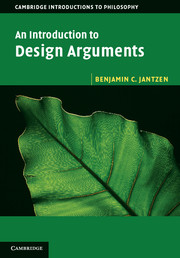Book contents
- Frontmatter
- Dedication
- Contents
- List of figures and tables
- Preface
- 1 Introduction
- 2 Preliminaries
- 3 Arguments from antiquity
- 4 Medieval arguments
- 5 The golden age of natural theology
- 6 Unusual design arguments
- 7 Hume
- 8 Paley
- 9 Darwin
- 10 Loose ends
- 11 The modern likelihood argument
- 12 Intelligent design I: irreducible complexity
- 13 Intelligent design II: specified complexity
- 14 What is complexity?
- 15 Supernatural agents and the role of laws
- 16 A brief survey of physical law
- 17 Fine tuning I: positive arguments
- 18 Fine tuning II: objections
- 19 Conclusion
- Bibliography
- Index
1 - Introduction
Published online by Cambridge University Press: 05 June 2014
- Frontmatter
- Dedication
- Contents
- List of figures and tables
- Preface
- 1 Introduction
- 2 Preliminaries
- 3 Arguments from antiquity
- 4 Medieval arguments
- 5 The golden age of natural theology
- 6 Unusual design arguments
- 7 Hume
- 8 Paley
- 9 Darwin
- 10 Loose ends
- 11 The modern likelihood argument
- 12 Intelligent design I: irreducible complexity
- 13 Intelligent design II: specified complexity
- 14 What is complexity?
- 15 Supernatural agents and the role of laws
- 16 A brief survey of physical law
- 17 Fine tuning I: positive arguments
- 18 Fine tuning II: objections
- 19 Conclusion
- Bibliography
- Index
Summary
What this book is about
Broadly speaking, we human beings use two conceptual schemes or ‘paradigms’ to explain the world in which we find ourselves. In the ‘teleological paradigm’ natural events are explained in terms of the same sorts of purposes, means, and goals we use to explain our own behavior. Within the ‘naturalistic paradigm’, the world is explained in terms of natural laws and mindless processes. The naturalistic paradigm has been enormously successful. As an underlying framework for science, this way of approaching the world has yielded a vast knowledge of natural phenomena, as well as the technology which distinguishes our modern way of life from all that came before. The teleological paradigm on the other hand is ancient and deeply intuitive. The oldest human accounts of nature were made from this perspective. The creation stories of cultures around the world – from the Babylonian account in which Merodach fashions the world from the corpse of the great Mother dragon Tiamat, to the biblical story of Genesis – are examples of teleological explanations. While such explanations have been largely displaced by appeals to natural law, one product of the teleological paradigm continues to remain relevant: the family of ‘design arguments’ for the existence of God.
Design arguments are characterized, not surprisingly, by appeals to design. Each such argument urges us to accept that one or another aspect of the world or of things in the world is the product of purposeful, intelligent agency. That is, each design argument attempts to establish that some aspect of the natural world was designed. From there, it is a short mental hop to the existence of a designer. After all, the presence of design in the world surely implies the existence of a designer. For the arguments we will examine, that designer is typically (though not always) understood to be the Christian God.
- Type
- Chapter
- Information
- An Introduction to Design Arguments , pp. 1 - 17Publisher: Cambridge University PressPrint publication year: 2014

